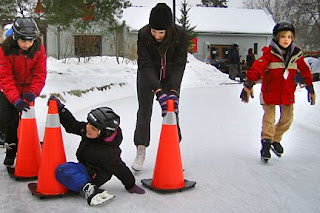 |
| Canon S90 set to automatic and hand-held. Image enhanced in Photoshop. |
 |
| Shot at dusk and the sky darkened in Photoshop. |
It is a cool spot and recently I had the chance to get some images of the park prior to its opening.
The trick here is to try and tell a story. Clearly the watering of the ice pad is a core image. For this you must set some clear goals: The water spray must be backlit to make it pop in the dark, the pavement must be wet with puddles to reflect the colourful lighting, and the large size of the pad and its curved shape must be clear. Shooting at dusk makes this all just a little easier. The shutter speed is faster. Still, bracing the camera on any solid, suitable surface is an excellent idea.
The Christmas lighting must feature in at least one shot. The outline of a steam locomotive was the obvious shot but it was important to include of the curving ice trail in the picture. This photo essay is about a location and we must work to locate each picture, where possible.
 |
| After getting permission, I shot the train lights from behind. Note the rink. |
Remember to shoot lots. This is especially true if you are shooting for the Web. You are not constrained by a finite expanse of paper on the Web, so take advantage of this fact. The rink can be seen behind the Christmas lighting locomotive but it is not especially clear. Punch up your photo story with one good image of the rink.
Photoshop is expensive. I own a copy because I am an ex-teacher and ex-photojournalist. At the least consider buying a program like Photoshop Elements to punch up you images before "publishing" your images on the Web. I like to think of this as electronically printing my pictures. Photoshop is my electronic darkroom.
 |
| Action's important. |

Oh, one last thing: Simple news pictures do not require model releases before publication. Even so, I often speak to the people in my images and make sure that they do not object to being in one of my online publications. If someone were to object, I would remove their image without argument.
To see how this approach worked with the same pictures presented on a different site, read my article on photostories posted on Digital Journal.

No comments:
Post a Comment